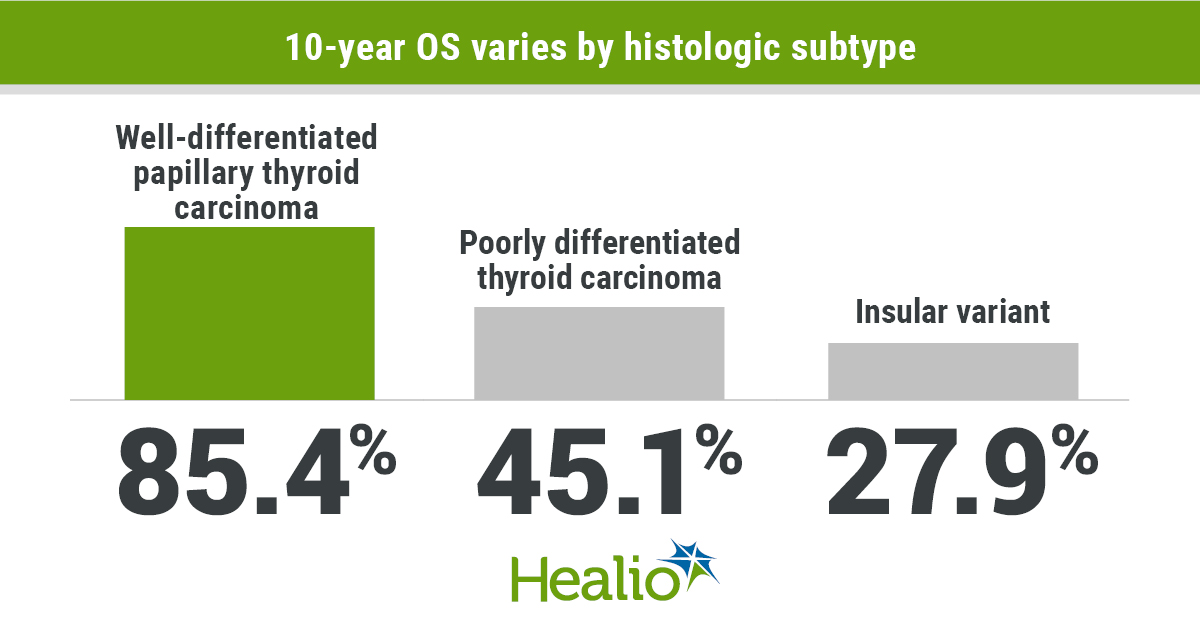‘Spectrum of risk’ exists for papillary thyroid carcinoma

Aggressive papillary thyroid carcinoma variants appeared associated with a wide range of survival outcomes, suggesting greater emphasis should be placed on tailored treatment approaches for patients with histologically and prognostically distinct subtypes, according to study results published in JAMA Oncology.
“We have empirically noted an increase in incidence of more exotic papillary thyroid carcinoma subtypes over time; however, the literature on these rare variants is not as robust as we would like,” Allen S. Ho, MD, director of the head and neck cancer program at Cedars-Sinai Medical Center, told Healio. “For instance, some papers find diffuse sclerosing variant to be aggressive, [whereas] others find it to be indolent. We furthermore saw that modern guidelines consolidate all papillary thyroid carcinoma subtypes as intermediate risk, when we were clearly seeing that they have different phenotypes. A spectrum of risk exists for thyroid cancers.”
Investigators examined incidence, clinicopathologic characteristics and outcomes of 5,447 aggressive variants of papillary thyroid carcinoma identified from hospital-based and population-based U.S. cancer registries. These included 415 diffuse sclerosing variant, 3,339 tall cell variant, 362 insular variant and 1,331 poorly differentiated thyroid carcinoma cases.
Median follow-up was 51.2 months (95% CI, 50.8-51.6).
For comparison, researchers identified 35,812 well-differentiated papillary thyroid carcinoma and 2,249 anaplastic cases.

The investigators used the weighted least-squares method to calculate age-adjusted incidence, Cox regression to assess OS and disease-specific survival, and propensity-score matching to adjust survival analyses for clinical and demographic covariates.
Researchers observed a significant increase between 2000 and 2016 in age-adjusted incidence of aggressive variants of papillary thyroid carcinoma (annual percentage change [APC], 9.1; 95% CI, 7.33-10.89) compared with well-differentiated papillary thyroid carcinoma (APC, 5.1; 95% CI, 3.98-6.12) and anaplastic thyroid cancer (APC, 1.9; 95% CI, 0.75-3.05).
Researchers also reported significant variation in survival among histologic subtypes.
Results showed 10-year OS of 85.4% (95% CI, 84.6-86.3) among those with well-differentiated papillary thyroid carcinoma, 79.2% (95% CI, 73.6-85.3) for those with diffuse sclerosing variant, 71.9% (95% CI, 68.4-75.6) for tall cell variant, 45.1% (95% CI, 40.2-50.6) for poorly differentiated thyroid carcinoma, 27.9% (95% CI, 20-38.9) for insular variant and 8.9% (95% CI, 7.5-10.6) for anaplastic cases (P < .001).
Estimated 10-year disease-specific survival was 96.7% (95% CI, 95-98.4) for diffuse sclerosing variant, 89.6% (95% CI, 87.6-91.7) for tall cell variant, 70% (95% CI, 67.3-72.8) for poorly differentiated thyroid carcinoma and 59.1% (95% CI, 51.0-68.4) for insular variant (P < .001).
Aggressive papillary thyroid carcinoma subtypes appeared more common among older individuals. Mean age was 56.3 years for those with well-differentiated papillary thyroid carcinoma, 56.9 years for diffuse sclerosing variant, 58.5 years for tall cell variant, 63.1 years for poorly differentiated thyroid carcinoma, 64.7 years for insular variant and 69.7 years for anaplastic cases.
“Current modern practices are increasingly minimalist and favor deintensification, whether it be with less extensive surgery, lower [dosage of levothyroxine (Synthroid, AbbVie)], lower radioactive iodine dosage or more relaxed surveillance protocols,” Ho told Healio. “Any or all of these could be ratcheted up depending on the subtype of cancer, as these treatment modalities may counter the risk for recurrence or decrease mortality risk.
“We have formed a subgroup of pathologists who focus on thyroid cancers, which has led to more consistent and accurate diagnoses of papillary thyroid cancer variants,” Ho added. “Building such expertise is clinically important when the treatment may be impacted by histology.”
Future research will examine histologic grade as a further predictor of thyroid cancer aggressiveness, according to Ho.
“Although external beam radiation therapy is not a standard treatment for thyroid cancer, we are also investigating its survival benefit for more aggressive forms of thyroid cancer,” Ho said. – by Jennifer Southall
For more information:
Allen S. Ho, MD, can be reached at Cedars-Sinai Medical Center, 8635 W. Third St., Suite 590 West, Los Angeles, CA 90048; email: allen.ho@cshs.org.
Disclosures: Ho reports no relevant financial disclosures. Please see the study for all other authors’ relevant financial disclosures.
